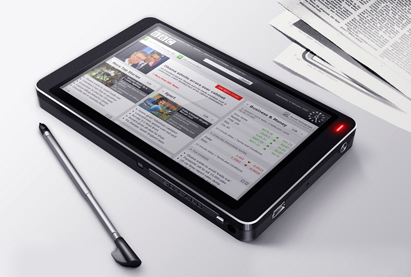This year’s CES2010 in Las Vegas had SmartDevices’ SmartQ V5 MID on display.We had a chance to examine its sibling, the SmartQ5. The operating system and hardware are practically identical for the two models, with the exception of RAM size and built-in memory card capacity.
It’s sometimes hard to understand the popularity of MIDs (Mobile Internet Devices). From one point of view, they are quite similar to smartphones based on Android, iPhoneOS, Symbian, or RIM. Alternately, MIDs might be marketed as very compact netbooks. What the SmartQ5 most resembles, however, is a classic Compaq (now HP) iPAQ on steroids, with enhanced RAM and CPU, and networking capabilities thrown in.
Hardware The SmartQ5 incorporates the ARM 1176- based S3C6410 Mobile Application Processor manufactured by Samsung Electronics. While normally clocked at 667 MHz, firmware tweaks can overclock the CPU to 800MHz. Though ‘tweaked’ firmware is officially supported (see http://www.smartdevices.com.cn/files/SmartQ5- v5.2-800.rar), there is an opinion that the installed RAM can’t run smoothly at the higher clock speed, so beware if you plan to try this. The 128 MB of internal memory might seem a bit modest for contemporary applications; however, it is more than adequate for watching movies and surfing the Internet. The SmartQ5 will enthrall Linux geeks – it runs Ubuntu Karmic! The operating system (including the /home and swap partitions) resides on a fast internal SD card. Unfortunately, the card has little free space for user data – though http:/en.smartdevices.com.cn/Products/SmartQ5/200905/27-7.html states: “1 GB Flash, 256 MB available to users,” a df listing via SSH shows roughly 93 MB free on the home partition:
$ df
Filesystem 1K-blocks Used Available Use% Mounted on
/dev/mmcblk0p1 632948 517000 83796 87% /
/dev/mmcblk0p2 122003 20380 95323 18% /home
The MID does have a free SDIO slot that supports up to 32 GB SDHC cards, though there’s a rather unfortunate catch: from my experience, and the fact that Task Manager has the option to “…switch between Bluetooth / the storage disk,” you can’t use a memory card at the same time as the included MiniUSB connector! While the MiniUSB connector would have been ideal for connecting Bluetooth devices or CDMA/3G modems, the hardware design of this particular MID makes it an either-or affair – considering the dearth of on-board storage, which is rather annoying.
The SmartQ5 features a standard 3.5-mm headphone jack – no need to worry about proprietary connectors and compatibility with other audio equipment. The 40mW output level generated by the SmartQ5 is enough to feed almost every external audio system. Besides, the built-in speaker’s maximum volume shames many notebooks’ on-board speaker systems (Figure 1). A hidden microphone provides for audio recording, though you’ll need to install recording software – only playback software is shipped in the SmartQ5’s default set-up. The screen measures 10.9 cm (4.3 inches), with a WVGA resolution of 800 x 480 pixels (Figure 2). This is overlaid with a resistive touchscreen, which is the sole means of input (the MID has no physical keyboard). From a usability point of view, the included stylus turned out to be required most of the time, since the UI is not finger-touch-friendly – more about that later.
The built-in 802.11b/g WiFi network card enables you to avail of speedy network connections when you have accessible hotspots nearby – and that’s becoming increasingly common today.The device is powered by a 2000 mAh LiPol (lithium polymer) battery. Though the manufacturer’s specifications page doesn’t make any specific claim about battery life for the MID, an informal test (recounted below) hints that it is quite adequate.With dimensions of 120 x 74 x14 mm, the SmartQ5 visually resembles a small brick. The body is made of dark gray plastic,and unfortunately, comes as a single moulded piece. This is a mixed blessing – on the one hand, even if the device falls from a height, it will survive with only scratches, and won’t break up.
On the other hand, the battery cannot easily be replaced, which means you’d either need to dispose of this device and buy a new one when the battery reaches its end of life, or break the case and lose the aesthetic appearance in doing so.Finally, three buttons on the upper side –- “+”, “-” and ‘maximize’ are used to manipulate sound volume and window size. The fourth, a slightly recessed power button, also serves to bring up the task manager. On the lower side of the device is a tiny, but important button that solves issues when the device has apparently frozen — the Reset button. When you try to open a big file in Abiword or in FBReader, it seems that the device has frozen. This is not actually the case – the OS is trying to free RAM by moving some memory pages into swap – but you can experience a really long delay. This is one case when you might want to reboot the device – just grab the stylus and hit the Reset button.
Software
As mentioned earlier, the MID runs a customised Ubuntu Linux 9.10 Karmic with kernel 2.6.24.7. Graphics are displayed via a frame-buffer device. Sound output via the specialised WM8987 DAC from Wolfson Microelectronics is driven by the ALSA (Advanced Linux Sound Architecture) subsystem. Desktop and window management is done by LXDE (Lightweight X11 Desktop Environment) and Openbox.
The UI sports a MacOS X-like Quick Launch bar with frequently-used applications like the Midori Web browser, Wi-Fi network connection manager, Task Manager, external MiniUSB modem connection manager, FBReader, the StarDict English-Chinese translation software, the Systems Manager, and a screen-lock function. The dock isn’t apparently customisable via the SmartQ5’s own UI – I guess you need to edit config files with Abiword, or with vi/nano via an SSH session.
The main menu provides categories similar to those seen on a larger screen computer, while the system notification area on the upper right provides the familiar volume and brightness controls, battery monitor and clock. The LXDE main menu’s categories provide several applications:
Accessories:
Galculator – a calculator with multiple display modes: Basic, Scientific and Paper. The latter will be interesting to old-school accountants.
Leafpad – A simple text editor; ideal for scripting, and similar to Windows’ Notepad.
Search for Files (the search is performed by PCManFM manager)
StarDict – translation between English and Chinese, and vice-versa.
Xarchiver – archive manager that handles tar, gz, bz2,lzma and rar archives.
Evilvte – terminal for command line users
Games:
Gweled (a FOSS version of PopCap Games’ immensely popular ‘Bejeweled’)
Shisen-Sho (a tile-based game of logic, of Japanese origin)
Graphics:
Evince Document Viewer – for PDF documents
Image Viewer
rgbPaint – a simple graphics editor akin to MS Windows’ Paintbrush
Internet:
Claws Mail – a popular branch of the Sylpheed e-mail client
Feed Circuit – an RSS feed reader
Midori Web Browser – quite a feature-packed Web browser, based on the WebKit engine. It boasts a plug-in subsystem compatible with Netscape (and obviously with several plug-ins from Mozilla as well). It passed ACID tests flawlessly. The available number of settings is modest, but provides enough control to deliver a pleasant surfing experience (Figure 4).
Pidgin – (formerly GAIM), a popular multi-protocol IM client
Transmission – yes, incredibly, a BitTorrent client!
Office:
Abiword word processor, FBReader e-book reader,Gnumeric spreadsheet
Osmo – a Personal Information Management (PIM) program with a task/to-do list alongwith reminders and alarms, contacts management, notes, and calendar integration.
Sound & Video:
SMPlayer – a GUI front-end for MPlayer, which plays both video and audio media.
Sonata – a GUI music player with a simpler interface than SMPlayer. It turns out that this application,though ostensibly an audio player, can handle video files too – just add them to the play list and hit ‘Play’!
System Tools: GDebi Package Installer, PCMan File Manager
Preferences: Appearance, Bluetooth, Language, Openbox Manager, SysSettings, Wicd NetManager
The system configuration applications allow you to change the system font, window manager appearance, settings for Openbox, language settings and more. Language, by the way, is restricted to Chinese and English only.
As far as actual package installation is concerned – GDebi has a nice GTK GUI interface, but is completely useless – it shows nothing. Hello, developers! To install software packages, I had to log in via SSH and run console ‘Aptitude’ commands. Note – to upgrade installed software or install new software, you’ll need an inserted SD card, because Aptitude generates index files that it seeks to store on the SD card.
Other software distributions
One of the great aspects of Linux embedded devices is that sooner or later, a variety of distributions become available to be installed/run on your hardware. As far as the SmartQ5 is concerned, at the moment, there is a stable release of MER version 0.16 available for download at:
http://wiki.maemo.org/Mer/Releases/0.16. The Android operating system is being adapted for Smart Q5 by a Japanese company named Covia – their special discussion forum is at: http://www.covia.jp/net/bbs/. Fresh firmware can be downloaded after registration, or you can grab it here:http://lib.paguro.ru/smartq/firmware/ANDROID/Q5_eclair_20100301_SDBoot.zip.
There is also a Windows CE release officially distributed by SmartDevices: http://www.smartdevices.com.cn/files/WinCE6.0_V2.0_SmartQ5.rar, but most Linux users will probably want to avoid proprietary closed-source operating systems!
Observations, impressions and comments
The touchscreen behaves like most resistive touchscreens, but with minor improvements. However, if used to multi-touch capabilities, you’ll probably miss them very much – such options and technology have been integrated into the Linux kernel just a couple of months ago, so don’t expect them to be available anytime soon. In general, in my purely personal opinion, the touchscreen’s protective plastic layer is somewhat thicker than most other devices I have used.
The filesystem for the system and user data is ext3. It would have been more logical to use a filesystem like JFFS2,and allocate swap space and /tmp space in RAM (while increasing the RAM on the device). Temporary files in RAM deliver faster access times compared to SD/HDD storage. Also, even the respected SanDisk-brand internal SD card may provide wear-leveling; several thousand cycles of rewriting in the swap area could quickly lead to bad blocks, and perhaps even memory corruption and device freezes/hangs. Whether the developers even considered this problem is unclear. On the brighter side, though: this behaviour is common with Apple’s iPod and iPhone products, which don’t use specially optimised filesystems either. Given the lack of complaints from iPod/ iPhone users, perhaps there will be no complaints on this front from SmartQ5 users as well.
LXDE and Openbox are, in principle, a great replacement for GNOME or KDE, and are really quick – but are more usable on a large-screen desktop system. Touchscreen-based systems like MIDs have different design constraints: they should be usable with fingers only, or at least with minimal stylus usage. Alas, the SmartQ5’s default Linux installation requires frequent stylus usage, which I found a bit boring. To scroll Web pages, you have to use the stylus every time – and this applies for almost all other operations on the SmartQ5, especially when you use the virtual keyboard. It is impossible to tap any single symbol accurately without using the stylus. Apparently, the GUI basically wasn’t optimised for the MID; the developers simply ported Linux from a big desktop system, and forgot to adapt for small-screen tasks and usability. I hope this will be fixed in future versions.
Concerning Abiword and Gnumeric – Abiword can handle documents from MS Office, OpenOffice and some other applications, and could be useful for a quick review of a document. Gnumeric, however, only handles documents in its own format. Both applications are superfluous on this MID, however, since it lacks a physical keyboard. With a hardware keyboard, these applications could be usable, though input would be slow. With a software keyboard only… sorry, there is no way you’re going to be tapping in large documents on this MID.
Osmo is a really nice organiser – in my opinion, this useful application should have been in the Quick Start dock by default. Now, it’s time to check the multimedia capabilities of this MID. According to performance tests I ran recently, the CPU speed of this MID is comparable to the Apple iPod Touch 2G/3G. Playback of an animation movie, Planet 51 (encoded with H264/FAAD AAC codecs in 480 x 208 resolution), was smooth and jerk-free (Figure 5). The battery charge decreased by approximately 30 per cent (from full charge) after 1.5 hours of playback. That would roughly indicate 5 hours of battery life for video playback; less-demanding tasks would naturally yield longer run-times.
Final remarks
This MID turned out to be solidly built. It is easy to use,and in my opinion a bit overloaded with functionality. Sized almost the same as the iPod Touch (with twice the thickness,however), it weighs around the same. I missed multi-touch navigation very much, though.
The biggest attraction of the SmartQ5 is that it runs Linux – you can run any Linux distribution that provides ARM binaries, including Ubuntu, Debian and Slackware. More interesting are the Android and MER firmware for this MID. MER, an open source implementation of the Maemo project once developed by Nokia, is interesting and new; I guess most SmartQ5 users will wind up running it, since it is ideally suited for finger-navigated software and applications.
Well, I hope Linux hackers will tweak and tune this MID to get the most out of it.










My cousin recommended this blog and she was totally right keep up the fantastic work!